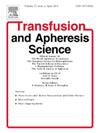重症监护病房COVID-19 ARDS住院患者医院获得性贫血的发生率及预测因素
IF 1.2
4区 医学
Q4 HEMATOLOGY
引用次数: 0
摘要
医院获得性贫血(aihospital acquired anemia, HAA)是指入院时血红蛋白浓度正常的住院患者发生的新发贫血。它是世界范围内重症监护病房(ICU)最常见的多因素合并症之一。本研究的目的是探讨ICU收治的COVID-19 ARDS患者HAA的发生率、预测因素及其与死亡率的关系。方法对2020年1月至2021年12月我院48张床位ICU收治的所有成人COVID-19 ARDS患者(n = 1007)进行分析。HAA被定义为ICU住院期间符合WHO标准的最低Hgb值。贫血进一步分为轻度、中度和重度贫血。未发生HAA的患者与发生HAA的患者以及HAA严重程度的分类进行比较。并对HAA和重度HAA的预测因素进行了分析。结果545例入院时无贫血的ARDS患者中,373例(68.4% %)发生HAA。大多数HAA患者为轻度贫血(168例,45.0 %),中度贫血127例(34.1 %),重度贫血78例(20.9 %)。死亡风险随HAA程度的增加而逐渐增加。入院时血红蛋白水平和ICU住院时间可预测HAA和重度HAA的发展;而神经系统合并症和血液透析需求是严重HAA发展的预测因素。结论haa在COVID-19 ARDS患者中常见。应提高预防ICU中发生HAA的认识,特别是对于入院时血红蛋白水平较低、神经系统合并症、ICU住院时间较长以及接受血液透析治疗的患者。本文章由计算机程序翻译,如有差异,请以英文原文为准。
Incidence and predictors of hospital acquired anemia in COVID-19 ARDS patients hospitalized in intensive care unit
Aim
Hospital acquired anemia (HAA) can be defined as a new-onset anemia in hospitalized patients who have a normal hemoglobin concentration at admission. It is one of the most common comorbidities with multifactorial causes in intensive care units (ICU) worldwide. The aim of our study was to investigate the incidence and predictors of HAA, as well as its relationship with mortality, in COVID-19 ARDS patients admitted to ICU.
Methods
All adult COVID-19 ARDS patients admitted to our 48-bed medical ICU between from January 2020 to December 2021 (n = 1007) were analyzed. HAA was defined as a nadir Hgb value during the course of ICU stay meeting WHO criteria. Anemia was further classified into mild, moderate and severe anemia. Patients who did not develop HAA were compared with those who develop HAA as well as with categories of HAA severity. The factors which can predict HAA and severe HAA were also analyzed.
Results
Among 545 ARDS patients without anemia at admission, 373 (68.4 %) developed HAA. The majority of HAA cases were mild (168, 45.0 %), whereas 127 (34.1 %) had moderate and 78 (20.9 %) had severe anemia. The risk of mortality progressively increased with increasing degree of HAA. Admission hemoglobin levels and length of ICU stay are predictive of the development of both HAA and severe HAA; while neurologic comorbidities and requirement of hemodialysis are predictive of development of severe HAA.
Conclusion
HAA is common in COVID-19 ARDS patients. Awareness should be raised to prevent the development of HAA in ICUs, especially in patients with relatively low admission hemoglobin levels, neurologic comorbidities, longer ICU stays and patients who undergo hemodialysis treatment.
求助全文
通过发布文献求助,成功后即可免费获取论文全文。
去求助
来源期刊
CiteScore
3.60
自引率
5.30%
发文量
181
审稿时长
42 days
期刊介绍:
Transfusion and Apheresis Science brings comprehensive and up-to-date information to physicians and health care professionals involved in the rapidly changing fields of transfusion medicine, hemostasis and apheresis. The journal presents original articles relating to scientific and clinical studies in the areas of immunohematology, transfusion practice, bleeding and thrombotic disorders and both therapeutic and donor apheresis including hematopoietic stem cells. Topics covered include the collection and processing of blood, compatibility testing and guidelines for the use of blood products, as well as screening for and transmission of blood-borne diseases. All areas of apheresis - therapeutic and collection - are also addressed. We would like to specifically encourage allied health professionals in this area to submit manuscripts that relate to improved patient and donor care, technical aspects and educational issues.
Transfusion and Apheresis Science features a "Theme" section which includes, in each issue, a group of papers designed to review a specific topic of current importance in transfusion and hemostasis for the discussion of topical issues specific to apheresis and focuses on the operators'' viewpoint. Another section is "What''s Happening" which provides informal reporting of activities in the field. In addition, brief case reports and Letters to the Editor, as well as reviews of meetings and events of general interest, and a listing of recent patents make the journal a complete source of information for practitioners of transfusion, hemostasis and apheresis science. Immediate dissemination of important information is ensured by the commitment of Transfusion and Apheresis Science to rapid publication of both symposia and submitted papers.

 求助内容:
求助内容: 应助结果提醒方式:
应助结果提醒方式:


